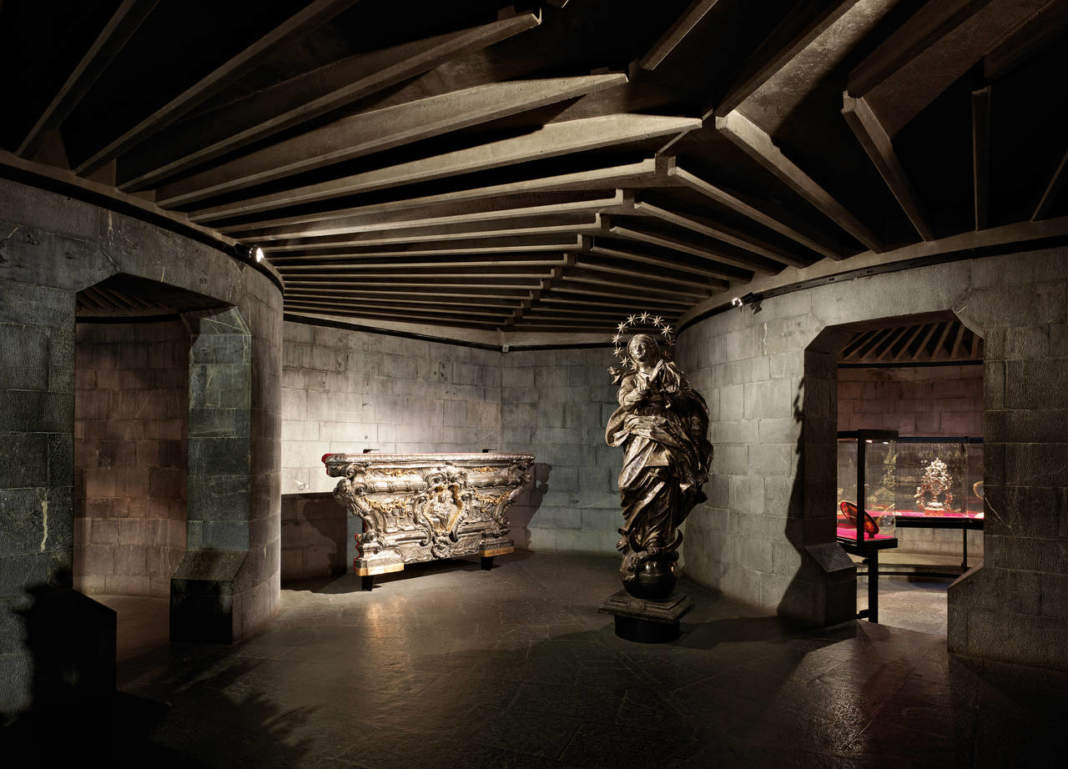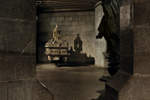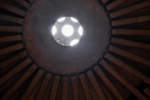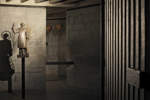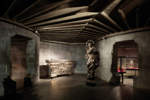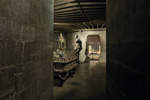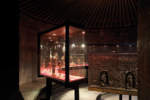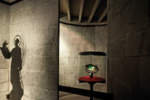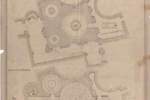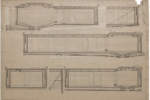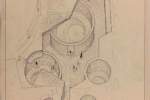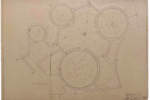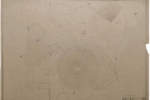museo del tesoro di San Lorenzo
photo by Pietro Savorelli
I will here attempt to analyse how many signs of introversion were manifest in the mature phase of Albini in the early Fifties, in relation to one of many themes associated with the still archaic classifications of the years immediately after World War II, Zevi’s alternation between internal space and external space, which even if abandoned, enjoys a revival today within the context of the revisionist debate on modernism. I cannot but back the appeal of those who, like him, turned to tradition, seeing their own profession from an innovative angle. Albini continued along his quiet path in the post-war years, conscious that the verifications and theoretical references, which nevertheless were to arrive later, could not obscure the quality of the work and its lasting place in Italian art. Introversion is the real face of this linear methodological proceeding, enunciated in trendy cenacles, while his research on the contrary faced alternating phases, between concluded experiences and new orientations. Around 1951 he commenced a series of works which entailed an implicit dissonant revision of the tools of his trade, such as the Gallery of Palazzo Bianco in Genoa, the INA offices in Parma and a residential complex at Cesate. On the conclusion of this phase, in 1952, he commenced the project in Genoa for the Museum of the Treasure of S. Lorenz, one of the greatest accomplishments of the master, but also a true or presumed departure from his path, on which to dwell for an introverted observation, which considers the reasons of a theme characterized by separate facts, and that implies the connection between an accomplished interior with another interior. A project which ventures beyond the conceptual references that had been already been experimented in the Thirties, in projects which had determined the peculiarity of the Milanese rationalist school, firm in theory but light in the actual style of finished works. This is also evident in the Cartesian approach characterizing the Palazzo Bianco, but the Museum of the Treasure of S. Lorenzo finally bears witness to a change in the signs of time and history, the introduction of a genetic mutation where the material substance and weight of the buildings are changed. The renovation of Palazzo Bianco originally represented an initial reflection, where twenty years of work were summarized and the primogeniture of his research reasserted, with the exaltation of a poised formal suspension of the art, whose stylistic cipher reaches the heights of lyric abstraction. Distant from primordial rationalism, Albini creates a trajectory around the great Manner, by inventing an abstractionism which tackles the composed construction of Alessi from within. A subsequent second revision is recognizable in the explicit quotation of the tapered design of the lakefront of the Promontory Apartments in Chicago, by Mies in his early American period, which has been influential to plan of the INA offices in Parma, where a rigorous geometric score is fixed by rules in glass, that are however ready to change in the distributive strategy of interior-exterior, in a manner comparable to the Renaissance ellipse of vertical connection. It is from this work built in 1951 that my research for an affinity with the New Masters has begun. The presence of Albini (and of Helg) at the building site has encouraged a clandestine observer like me to appreciate the composition of the parts and the sequence of the building process. An outdoor design school which in fact changed my relationship with my study plan at the Polytechnic, making me analyse the thought of the self-same Albini, advocate of coherences verging on the paradoxical (his legendary figure, the intangibility of a Calvinist compositive method), challenged by the implicit reasons of the building site. As I was able to observe, in the sequence proceeding from structure, to pillars (tapered) to non-structural walls (with facing) and the progressive installation of the other components, the modular scheme of Mies acquires a new meaning, regaining a concrete definition which determines the difference from a mere quotation of an ideal connection to a minor Mies. The imaginative revelation of his identity and history in the pompous interior of the palace in Genoa, along with the quotations of Mies in Parma, asserted and then superimposed by decorative scores, witness the constant action and internal disquiet which have then inspired the project at Cesate. The latter vaunts a succession of unusual typologies arranged without any regard to the schemes of orthodox rationalism, where rows are changed into an improbable dovetailing (with the pretext of heliothermal orientation) to invent a mechanical device, a feat of ingenuity, which bears witness to underlying perplexities that were already perceptible in the contemporary IACP building in the Mangiagalli district (in collaboration with Gardella). An examination of the works designed in the same period once again reveals different variations and variations in the planning methods. In the small district, Albini isolates himself, tackling elaborations of abstract typologies, while retaining the usual technological traits that are clearly distinct from the contributions of his fellow architects Gardella and BBPR, more attentive to the suggestions of a mannerist populism.
* * *
The trajectory formed by Albini’s works from the early Fifties therefore reveals distinct paths that, while all are characterized by the same patient persistence, bear witness to progresses, pauses and motivated re-awakenings, all recognizable and retraceable to his work as an artist of the European avant-garde. One perceives a disquietude that becomes incessant research, and culminates in excellent results, in the first project, the renovation of Palazzo Bianco (1949-51), where the reports show concise signs of his association with the trend, characteristic of the historical avant-gardes, which identify an integration between old building and innovative intervention as the correct approach. It is a matter of the realization of that step to be taken which was later clarified (the debate on old towns) which the theoretical prospects of architecture had not yet defined. The last point in the sequence, the Treasure of S. Lorenzo, has another story: commenced on the completion of the renovation of Palazzo Bianco, it was designed in the basement, below a courtyard of the Archbishopric. The architect thus proceeded to build a crypt, detached from the apse of the Cathedral, inventing a space adjacent to the sacristy, where the fulcrum of the Museum was enriched by the mutual autonomy between interior and exterior: the tholoi (as it was informally called in Albini’s studio) are connected and distinguished by a geometric area forming a regular hexagon (a diffused design in the post-war years) whose sides converge in the centre of the three main environments. The geometry intersects to form canonical figure which, before being involved in a certain spatial arrangement, stand out with formal autonomy (the hexagon, the cylinders characterized by an almond-shaped section) to subsequently determine interstitial itineraries, ambulatories placed outside the main exhibition areas. The underground space thus created becomes charged with evocative values, highlighted by the use of Promontorio stone (the reference to the Mediterranean of Mycenaean tholoi), which takes the form of thick slabs, also on the floor where they form a radial design that mirrors the disposition of the roof beams. It is, in the final analysis, a matter of a project in a unique site where Albini, fascinated, introduces the archaic measure of a transcendent time in the composition, preferring to focus on the heaviness of materials that have been handed down since time immemorial, celebrating them, in an ideal crypt of stone – sculpted by hand, with gradine and scalpel – as a homage to an aulic tradition of architecture and construction, to a historical use of building instruments. Within the context of a debate on tradition in architecture launched by Casabella-Continuità in 1955 (at a time when the project was not yet complete) Albini testified that “I believe architecture is today projected towards a present reality, which is the product of numerous current and past components, in an attempt to take cognizance of this reality”. A statement in favour of “realism”, a cultural suggestion for a possible future, which the Italian architectural school of critical rationalism has proven able to follow.


